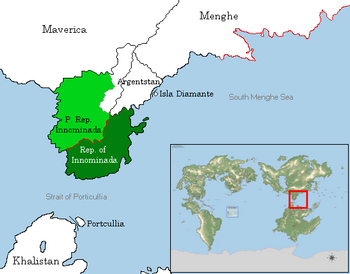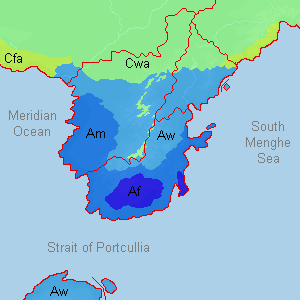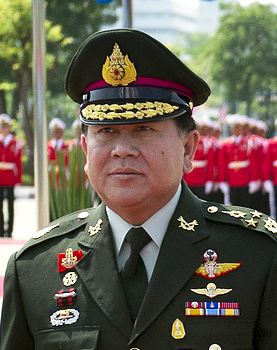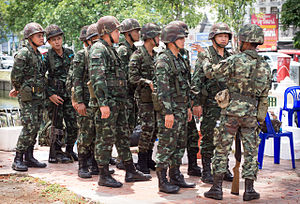Republic of Innominada
Republic of Innominada Republica de Innominada สาธารณรัฐ อินโนะมินาดะ ສາທາລະນະລັດ ອິນເນາະມິນາດະ | |
|---|---|
 Location of the Republic of Innominada in Septentrion, as it appeared after Argentstan's secession. Dark green: controlled areas. Light green: claimed areas. Red: demilitarized zone. | |
| Capital | San Miguel |
| Largest city | Puerto Alegre |
| Recognised national languages | Sylvan Kedi Argentan |
| Recognised regional languages | Taleyan |
| Ethnic groups (2017 est.) | 39.2% Mestizo 27.9% Kedi |
| Demonym(s) | Innominadan |
| Government | Military junta |
• General | Thanasak Chaychna |
| Sovereign State | |
• Kingdom of Samsanekedi | 162 CE |
• Independence from Menghe | 1520 |
• Independence from Sylva | 7 August 1883 |
• RoI established | 25 July 2015 |
| Area | |
• Total Land | 370,751.80 km2 (143,148.07 sq mi) |
• Water (%) | 0.8% |
| Population | |
• 2019 census | 24,620,000 |
• Density | 66.41/km2 (172.0/sq mi) |
| GDP (PPP) | 2019 estimate |
• Total | $236 billion |
• Per capita | $9,585 |
| GDP (nominal) | 2019 estimate |
• Total | $132 billion |
• Per capita | $5,361 |
| Gini (2019) | 41.8 medium |
| HDI (2019) | high |
| Currency | Republican Dollar (RID) |
| Time zone | UTC+5 |
| Date format | yyyy-mm-dd; CE(AD) |
| Driving side | right |
| Calling code | +96 |
The Republic of Innominada (Sylvan: República de Innominada; Kedi: สาธารณรัฐ อินโนะมินาดะ, Satharnrath Xinnoaminada; Argentan: ສາທາລະນະລັດ ອິນເນາະມິນາດະ, Santhanalad Innominada), also known as South Innominada and abbreviated RoI, is a country in South Hemithea, Septentrion. It was formerly part of Innominada, but was split off as part of the Menghean-occupied zone following the Innominadan Crisis in 2015. It borders the People's Republic of Innominada to the northwest and Argentstan to the northeast, with its south coast running along the strategic Strait of Portcullia.
Prior to colonization, the south coast of the Innominadan Peninsula was home to a collection of small kingdoms and city-states, which flourished on the lucrative trade network linking Menghe to Meridia. The local population was mostly Kedi-speaking, and after the 10th century, predominantly Shahidic. The Yi dynasty conquered the area in 1317 and ruled it for two hundred years.
Not long after breaking away from Menghe, the independent kingdoms were annexed by Sylvan conquistadors, who integrated them into the colony of Innominada. Innominada transitioned to commonwealth status in 1883, and in 1967 a syndicalist government took over the country.
In 2014, Innominada descended into civil war, with the main opposition force establishing a stronghold in the south. Menghe invaded on September 21st, carving out the Republic of Innominada and installing Martínez's opposition force as the new government. Tensions between the Martínez government and Menghe continued to grow, particularly after Argentstan's secession referendum, and in January 2018 Menghean troops intervened to establish the Second Innominadan Republic under General Thanasak Chaychna.
Name
When the first Sylvan explorers arrived on the west coast of Hemithea, they labeled the region Terra Innominada, literally "Unnamed Land," on their maps and in their records. Originally, they applied the name to the entire continent, to express its unknown status and unclear extent. Although it was likely intended as a temporary label, pending a royal decision on whether to name the new land after the King or one of the lead explorers, the name stuck, and by 1510 it was recognized as the official name of Sylva's colonial possessions along the west coast.
Following partition in 2015, the Maverican-backed government retained the full title People's Republic of Innominada, claiming to represent the prewar government of the whole country. The Menghean-backed portion adopted the full title "Republic of Innominada." The Republic of Innominada is sometimes referred to as South Innominada, but it officially eschews this label, which implies that it does not lay claim to the north of the peninsula.
Some figures in the Thanasak government have floated the idea of renaming the country Kedia, after the Kedi people native to the region. As of November 2019 the leadership of the country has not officially adopted this proposal for discussion.
History
Precolonial history
The first organized states on the South Innominadan Peninsula appeared during the 2nd century CE. Most of these were small, Kedic-speaking lowland city-states which relied on fishing and rice farming. As the cross-strait sea trade between Menghe and Meridia expanded from the 7th century, the coastal kingdoms flourished, growing to eclipse their inland counterparts.
Sea trade brought the coastal kingdoms into contact with Taleyan merchants from West Meridia, who brought Shahidism to the region. In tandem with the rise of the Ao Mangkot Sultanate in what is now Argentstan, Taleyan-dominated states extended their control inland, fusing Shahidic teachings with local cultural practices.
The Menghean Yi dynasty launched an invasion of the southwestern regions in 1292, proceeding first through Lakkian lands and then into Ao Mangkot. Yi troops completed their conquest of Southern Innominada in 1317, ending the Southwest Expedition and establishing dominance over trade in the South Sea Crescent. Menghe administered the south coast territories directly through its own administrators, but allowed local linguistic and cultural practices to continue. Menghean rule lasted two centuries, ending abruptly in 1521, when the Menghean Black Plague incapacitated the country's central leadership and allowed Kedi rebels to launch a successful uprising.
Colonial rule
The hard-fought independence of the South Coast kingdoms would prove short-lived. Almost as soon as word arrived that Menghe had lost control of the region, Sylvan conquistadors launched an invasion from the west, attacking the outermost of the states in 1524. By this time, the Black Plague was wreaking havoc in Kedi lands as well, and it had been joined by smallpox and other diseases to which the conquerors were immune. By 1533, the conquistadors had established control over all of what is now the Republic of Innominada, as well as most of what is now the People's Republic.
Because the southern areas of the colony were already densely populated when the conquistadors arrived, the Sylvan leadership adopted a different approach from the small-parcel settlement of the northwest. Farmland in the south was collected into large hacienda estates, which were handed out to conquistadors as a reward for their service. The native people living on these estates were tied to the land as slaves. Abuse, summary execution, and repeated disease flare-ups steadily drained the local population, and sexual relations between masters and slaves gave rise to a new social class of Mestizos, or mixed-race persons. In 1654, fearing that the slave population would be exhausted, the Viceroy of Innominada forbade procreation between Creoles and natives, allowed non-Creoles to practice religions other than Catholicism, and required that slaves be allowed to farm some of the land for subsistence. The resulting system of serfdom and segregation, later copied to the Northeast Frontier, stabilized the population ratio but maintained a racial hierarchy which would long trouble Innominadan society.
Partition
After a disputed election on March 9th, 2014, Innominada slipped into a violent civil war. Hernan Martínez, the leading opposition candidate, had built his main electoral base in the south of the country, which also became his main power base in the civil war. As most government soldiers were deployed near the Menghean border and along the coast, rebels were able to carve out an independent area of control around San Miguel, which became the informal capital of the rebel movement.
When Menghe invaded Innominada on September 21st, ostensibly to restore order but also to pre-empt a Sylvan and Sieuxerrian invasion of the mainland, it declared its support for Martínez's "Republica Libre del Sur" movement. Maverica responded by moving its own troops into government-controlled areas, hoping to prevent a total collapse of its ally. On the night of September 29th, Menghe and Maverica reached a last-minute agreement to partition Innominada along its provincial boundaries into two zones, thus avoiding runaway escalation between Septentrion's two largest militaries. Menghe's occupied zone, later dubbed the Republic of Innominada, ran along the southeast coast from the Menghean border to the outskirts of Grenada. Advisors in the Menghean Ministry of National Defense chose this partition in order to gain control of the north coast of the Strait of Portcullia, a strategic approach route for any hostile fleet moving from Casaterra to Menghe. In return, they ceded the provinces of Mojana and Cauca, which would later become important territorial claims for Argentstan.
Initially, the Menghean Special Liaison to Innominada allowed the Martínez government to operate with full autonomy in its domestic affairs as long as it provided military support to Menghe. Menghean leaders were particularly adamant that they did not intend to export the "Menghean model" of government and economics, believing it inappropriate for countries with different histories and cultures. As time passed, however, the Menghean government grew dissatisfied with Martínez's handling of domestic terrorism, economic growth, and ethnic relations, and their Innominadan counterparts grew irritated with what they viewed as Menghean meddling in their sovereign affairs.
Innominadan Second Republic
Tensions between Menghe and the Republic of Innominada broke out into the open in January 2018, when the Special Liaison announced that it would allow a referendum on Argentstani secession to go forward despite opposition from the Cabinet and the legislature. Martínez responded by drafting a declaration that Innominada would withdraw from the Namhae Front and expel the Menghean troops on its territory. Alarmed at what they saw as a critical security threat, the Menghean Army launched Operation Mallet, sending the 5th Army to restore order and remove Martínez and his allies from power. A string of pitched battles with Innominadan soldiers and militia broke out along the way, resulting in 161 Menghean military deaths and between 573 and 2,300 Innominadan deaths.
After arresting Prime Minister Martínez and dissolving the legislature, the Menghean Army handed power to a military junta comprised of Innominadan military commanders who had backed the Menghean intervention. Most of these commanders, including the junta chairman, General Thanasak Chaychna, are ethnic Kedis, who in general have been more supportive of Menghe's role in the country in light of past racial discrimination. The Special Liaison to Argentstan and Innominada also adopted a much more active role in the RoI's domestic politics after the crackdown, in order to control terrorism and revitalize the stalled economy.
With Martínez's decree cancelled, Argentstan's secession process was able to move forward as planned, officially completing on June 6th 2018. The three northeastern provinces of Chaco, San Luis, and Flores formed the de facto area of the new state. The Republic of Innominada also relinquished its claims to Isla Diamante and the two Innominadan provinces of Mojana and Cauca, to prevent overlap with Argentstan's own territorial claims.
Geography

Over most of its extent, the Republic of Innominada's borders are defined by the Sierra Verde mountains in the north and the ocean on the south. The provincial borders which formed the basis for the postwar national borders do not perfectly correspond to the highest points along the ridge, but the Sierra Verde range does present a natural obstacle for any invasion of either Innominada by the other side. Along its coast, the Republic of Innominada borders the South Menghe Sea, the Strait of Portcullia, and, for a short stretch, the Meridian Ocean.
As part of the partiton agreement signed between Menghe and Maverica, the border between the two Innominadas is surrounded by a demilitarized zone extending two kilometers to either side of the boundary. This zone mainly exists to prevent unauthorized exchanges of small-arms fire by soldiers on either side, which could escalate into a larger war. The Republic of Innominada maintains a system of fences and guard posts along its edge of the DMZ, intended to catch infiltrators - and, increasingly, to stop defectors.
The Republic of Innominada has a humid, tropical climate, with particularly heavy precipitation during the summer. The predominantly tropical monsoon climate of the south of the country surrounds an area of tropical rainforest climate south of the capital, San Miguel. Historically, most of the peninsula's southern half was covered by rainforest and jungle, but under colonial rule and during the era of the unified People's Republic, the agriculture and lumber industries drove relentless deforestation. Enforcement of anti-logging laws remains inconsistent today.
Government and politics
Since the Menghean military crackdown in January 2018, which deposed Prime Minister Hernan Martínez, the Republic of Innominada has been ruled by a military junta. Officially called the Council to Restore Order and Save the Homeland, the junta was appointed by the Menghean Army, and is made up of predominantly ethnic Kedi officers known for prior statements in support of Menghe. The junta chairman, General Thanasak Chaychna, was a prominent militia leader during the civil war, and is known for making strong statements in favor of a Kedi-dominated state to parallel Argentstan in the north.
The new regime has resorted to heavy-handed repression in an effort to deter racial conflict and suppress terrorism. Reports of mass detentions and summary executions are common. Political speech and public assembly are tightly curtailed, and all major media outlets are controlled by the government, which strictly censors their content. Documents leaked in 2019 indicate that the Republic of Innominada is building up a large secret police force, backed by a large corps of undercover informants recruited from the general public, and several of these documents mention the involvement of Menghean AI, cybersecurity, and surveillance firms. Critics have labeled the Republic of Innominada as a totalitarian regime, with more brazen coercion than the preceding People's Republic of Innominada, though it is not clear whether this repression is a permanent strategy or a temporary response to postwar instability.
Behind the scenes, the Menghean Special Liaison to Argentstan and Innominada has also played a very active role in shaping the Second Republic's domestic policy. The Special Liaison does not disclose any information surrounding its budget or staff, but fragmentary leaked reports suggest that it dramatically expanded its operations after the Menghean crackdown. Some scholars regard it as the ultimate center of political authority in the country, with Thanasak's junta serving as a figurehead.
Military
The Republic of Innominada has a system of universal military service, based on the Menghean model. All male citizens who reach the age of 18 are required to serve two years of active military service, followed by eight years of reserve service. Across all branches and services, the Republic of Innominada Armed Forces counted roughly 450,000 active-duty personnel in 2019, or about 1.8% of the total population. Reservists, once fully trained and equipped, will add an additional 1.6 million.
The active-duty total is broken down as follows:
- Innominadan Republican Army Ground Force: 240,000
- Innominadan Republican Border Force: 80,000
- Innominadan Republican Guard: 40,000
- Innominadan Republican Navy: 40,000
- Innominadan Republican Coast Guard: 15,000
- Innominadan Republican Air Force: 35,000
All major branches, save for the Republican Guard, serve in racially integrated units, a measure intended to build national unity among ex-conscripts. The Republican Guard is the main exception: it was established in 2018 as a coup-proofing measure in response to the Innominadan Uprising, and recruits exclusively from ethnic Kedis and Argentans. It consists of eight reinforced brigades, plus supporting command elements, which are distributed throughout the country in second-line positions. At least three Republican Guard brigades are known to issue commands in Kedi; all other units communicate in Sylvan.
Beneath the active forces, the Innominadan military has several reserve arms. All able-bodied citizens living near the Sierra Verde mountains are nominally part of the Front-Line Defense Militia, which is tasked with staging an insurgency against invading enemy rear-area units or infiltrating across the border. Ex-conscripts in their first eight years after service are split up across the active branches, with the Ground Force taking the lion's share. Ex-rebels, able-bodied locals, and ex-conscripts above eight years may also be organized into neighborhood emergency militias for rear-area security or emergency response duties.
As of 2019, the Republic of Innominada Armed Forces use a combination of Innominadan equipment captured during the civil war and Menghean equipment imported after the war's end. Of the remaining Innominadan small arms, weapons originally chambered in 5.7x40mm AVA been re-chambered in 5.7mm Quinn, to maintain ammunition and magazine compatibility. Some 7.62×39mm weapons still remain in service, mainly in reserve units, but current procurement plans aim to fully adopt the JS-103 assault rifle and its variants.
Demographics
Of the four polities into which Innominada was partitioned, the Republic of Innominada is the most ethnically diverse. Prior to colonization, it hosted a large population, mainly made up of ethnic Kedis but with functionally independent tribes in the jungles and mountains. Even after plague and abuse reduced the indigenous population, it remained denser than the indigenous presence in the northwest, and eventually recovered. Additionally, more than a century elapsed between the conquest of South Innominada and the Viceroy's decree against intermarriage, and by the mid-17th century there was already a sizeable Mestizo (or mixed) population.
A population estimate taken in 2017, with the three provinces that became Argentstan excluded, yielded the following statistics on population makeup, which can also be condensed to 23.4% Creole, 39.2% Mestizo, and 36.8% indigenous (all types).
- 39.2% Mestizo
- 27.9% Kedi
- 23.4% Creole
- 6.2% Argentan
- 1.4% Taleyan
- 1.3% other indigenous
- 0.6% other
In a further legacy from the period of early colonial rule, most Mestizos and Kedis in what is now the Republic of Innominada speak Sylvan and practice Catholicism, in contrast to Argentstan, where Argentan and Shahidism remain widespread. Under both the First and Second Republics, indigenous rights movements have organized campaigns encouraging Kedis and Mestizos to embrace their linguistic and religious roots, though recent surveys suggest that most still prefer Sylvan as their spoken language.
Flag and coat of arms
The flag of the Republic of Innominada was selected in 2014 as the symbol of the rebel opposition against the People's Republic. The blue stripes represent the blue sky and sea, while the white stripe represents morality and virtue. Originally, the three red stars represented the values of Liberty, Unity, and Equality, while informally they were also said to represent the union of Creoles, Mestizos, and indigenous peoples, each of whom make up roughly a third of the Republic's population. After the Menghean crackdown in 2018, the second interpretation became the official one.
The coat of arms of the Republic of Innominada, reproduced at right, contains a triangular crest whose three sides also represent the three values or the three racial groups. The crest depicts five mountains, representing the Sierra Verde range, rising from the sea. Above the mountains is a scroll of parchment, surrounded by shining light, bearing the declaration Fraternidad de Todos Pueblos (Brotherhood of All Peoples). This, too, originally read Libertad, Unidad, Egalidad. Behind the triangular crest are five Republican flags, positioned so that three red stars on each side are visible. The entire crest is surrounded by a laurel wreath tied at the bottom by a sky-blue ribbon.






